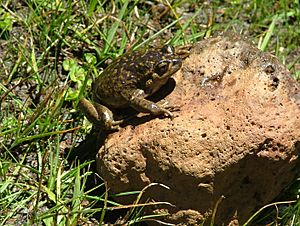Alsodes pehuenche facts for kids
Quick facts for kids Alsodes pehuenche |
|
|---|---|
 |
|
| Conservation status | |
| Scientific classification |
The Alsodes pehuenche (say: Al-SO-deez pay-WEN-chay), also known as the Pehuenche spiny-chest frog, is a special type of frog. It belongs to the Alsodidae family. This frog lives only in a small area of the Andes mountains. You can find it in the Pehuenche Valley in southern Mendoza Province, Argentina, and nearby Chile.
In 2012, experts knew about this frog in just six streams. These streams covered an area of about 9 square kilometers. Later, in 2013, they found it in a few more places, including another stream in Chile.
Contents
Where the Pehuenche Frog Lives
The Alsodes pehuenche frog loves water! It mostly lives in small, permanent streams. These streams get their water from melting snow. They have stony banks and are covered with grassy plants.
You might also find this frog in ponds or swamps. These watery spots also come from melting snow. The frog lives high up in the mountains. Its home is usually between 2,000 and 2,523 meters (about 6,560 to 8,278 feet) above sea level.
What Does the Pehuenche Frog Look Like?
This frog has a strong, bulky body. Its arms and legs are also quite robust. The head is wide, and its snout is short and rounded.
Male frogs found in Chile measured about 51 millimeters (2 inches) long. Female frogs were about 50.4 millimeters (2 inches) long. The frog's back is light brown. It has blurry, dark spots that are not in a regular pattern. Sometimes, you can see yellowish spots, especially on the females.
How the Pehuenche Frog Grows
This frog grows very slowly. It takes a long time for a young frog to change into an adult. Scientists believe it takes at least four winters for the frog to complete its metamorphosis.
Why This Frog Needs Our Help
The Alsodes pehuenche frog is in serious danger. Experts from the International Union for Conservation of Nature (IUCN) say it is "Critically Endangered". This means it is very close to disappearing forever.
The streams where these frogs live are being affected by a new highway. Paving the highway can change how water flows. It might also make the water dirty, especially if salt is used on the road in winter. Other problems include trash left by tourists. Also, livestock like cows or sheep walking through the streams can harm the frogs' homes. Because this frog lives in such a small area and faces these threats, it needs our protection.
See also
 In Spanish: Ranita del Pehuenche para niños
In Spanish: Ranita del Pehuenche para niños


